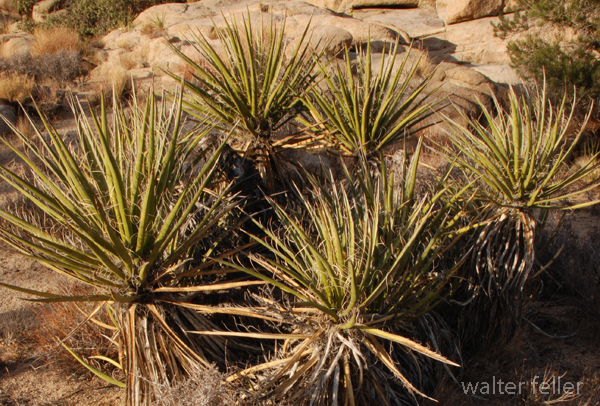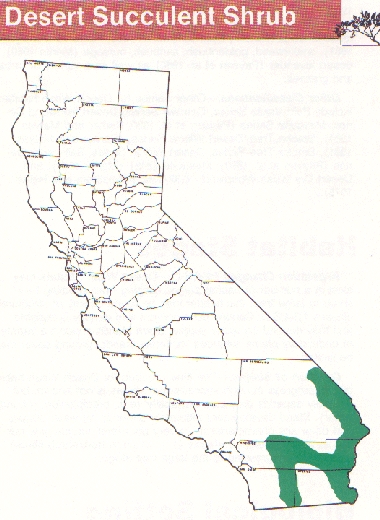Desert Shrub Dominated Wildlife Habitats
Desert Succulent Shrub
(DSS) Octillo, Mojave Yucca, Desert Agave
Vegetation
Structure-- Desert Succulent Shrub habitats typically are low, open (Küchler 1977) shrublands dominated (at least visually) by stem (Burk 1977, Paysen et al. 1980) or other succulent plants. When Joshua trees are present in any number the habitat is considered a Joshua Tree habitat. Heights of overstory vegetation usually range from 1 to 2 m (3 to 7 fl) unless plants such as ocotillo or saguaro are present; in these areas, heights may approach 15 m (50 ft) (Benson 1969). Desert Succulent Shrub stands usually are denser than creosotebush and constituent shrubs generally are more evenly spaced. In spite of greater density, crowns generally do not touch (Cheatham and Haller 1975). Nonsucculent subshrubs typically comprise the understory (Paysen et al. 1980).
Composition-- Overstory dominants include succulents such as ocotillo, Mojave yucca, desert agave, buckhorn cholla, teddybear cholla, branched pencil cholla, beavertail pricklypear, grizzlybear pricklypear, hedgehog barrel cactus, barrel cactus, fishhook cactus, hedgehog cactus, and saguaro (Cheatham and Haller 1975, Burk 1977, Küchler 1977, Paysen et al. 1980, Parker and Matyas 1981). The understory is comprised of species such as creosotebush, white bursage, and white brittlebush (Paysen et al. 1980, Parker and Matyas 1981).
Other Classifications-- Other names for Desert Succulent Shrub include Ocotillo Series (Paysen et al. 1980, Parker and Matyas 1981), Agave Series, Opuntia Series (Paysen et al. 1980), Cholla Series (Parker and Matyas 1981), Cactus Scrub - 44 (Küchler 1977), and Desert Cactus Scrub - 3.52 (Cheatham and Haller 1975).
Habitat Stages
Vegetation Changes-- 1;24:S-M. After disturbance, seedlings of short-lived shrubs, suffrutescent perennials, white bursage, and teddybear cholla establish rather rapidly; large-scale recruitment of longer-lived species (e.g., creosotebush) may take much longer (Vasek 1980)(No Habitat Lit Cite for Vasek 1980. There is a Vasek 1979 and a Vasek and Lund 1980. I used Vasek 1979 in Lit Cite at end.). Once established, Desert Succulent Shrub habitats slowly proceed from seedlings to mature plants. This habitat may exist as any of structural classes 1 ;2-4:S-M. Seedlings may establish by germination or by rooting of stem joints. Reproduction by rooting of stem joints may be especially important for the genus Opuntia. Seed dispersal, especially of cactus fruit is often aided by animals that feed on the fruit.
Duration of Stages-- Development of Desert Succulent Shrub habitats is relatively slow because many of the more conspicuous plant species are slow growing. The time required to proceed through the successional stages is not fully known; but is probably quite variable depending on climatic and soil factors as well as plant species comprising the habitat.
Biological Setting
Habitat-- Desert Succulent Shrub habitats generally grade into Desert Scrub (DSC) assemblages (Burk 1977). Other adjacent habitats include chaparral (Paysen et al. 1980) especially Chamise-Redshank Chaparral (CRC), Joshua Tree (JST), and Desert Wash (DSW).
Wildlife Considerations-- Desert Succulent Shrub habitats have greater floral diversity and structural complexity than most surrounding areas. These characteristics result in greater animal densities and more wildlife species than in adjacent habitats.
Physical Setting
Desert Succulent Shrub habitats are generally found on south facing slopes (Cheatham and Haller 1975, Burk 1977, Küchler 1977, Parker and Matyas 1981); however, bajadas with excellent drainage may also support stands (Cheatham and Haller 1975). Soil characteristics are variable; different soil characteristics may result in floristic differences between areas. In general, Desert Succulent Shrub habitats are found on rocky soils (Cheatham and Haller 1975, Burk 1977, Paysen et al. 1980, Parker and Matyas 1981) that are well drained (Cheatham and Haller 1975) but may be well developed (Burk 1977). Stands dominated by chollas may also be found on fine textured soils (Burk 1977, Parker and Matyas 1981) that generally are warm with a high soil moisture content (Burk 1977). Hot, dry summers and cool to cold, moist winters are characteristic of Desert Succulent Shrub habitats. Highest July temperatures range from 29 to 47 C (84 to 117 F) and lowest January temperatures range from 8 to 2 C (18 to 28 F). (Rowlands et al. 1982, P. G. Rowlands, pers. comm.). Most precipitation occurs in winter but summer rains fall especially in southeastern California. Total precipitation ranges from 15 to 27 cm (6 to 11 in) per year but potential evapotranspiration is from 2 to 7 times precipitation (Rowlands et al. 1982, P. G. Rowlands pers. comm.
Distribution
Desert Succulent Shrub habitats can be found in suitable locations from the southeastern Mojave Desert south through the Sonoran Desert into Mexico (Paysen et al. 1980). These habitats are found at elevations between 2000 m (6560 ft) (Rowlands et al. 1982) and 760 m (2500 ft) (Parker and Matyas 1981).
California Wildlife Habitat Relationships System, California Department of Fish and Game, California Interagency Wildlife Task Group, Desert Succulent Scrub - William F. Laudenslayer Jr.

Summary:
Cactus-Yucca Scrub
Cactus, or mixed desert scrub includes the popular notion of "desert." Barrel cactus are prominent ...Ecosubsections:
Mojave Desert
-
Providence Mountains - Lanfair Valley (322al)
Piute Valley - Sacramento Mountains (322am)
Bullion Mountains - Bristol Lake (322ao)
Lucerne - Johnson Valleys and Hills (322an)
Pinto Basin and Mountains (322ap)
Geomorphology: